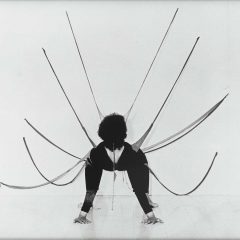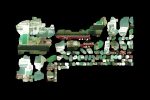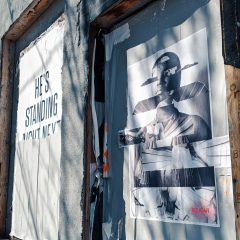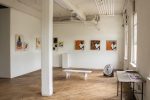The Kensington neighborhood is packed with rich communal healing spaces thanks to Art Dept Philly, Franny Lou’s Porch, Amalgam Comics & Coffeehouse, and Addie Addye’s soon-to-be opened studio space. Harlem-born Makeba Rainey is eager to join their ranks this fall with B(A)LM Studios — a gallery operating out of her house on Huntingdon St. Meanwhile, as a NARS (New York Art Residency and Studios) Foundation resident and a CFEVA (Center for Emerging Visual Artists) fellow, she is focusing on creating a new body of works centering black women and gentrification. I walked down Frankford Avenue with her, eyeing noticeable changes in the area, and stopping by Little Baby’s Ice Cream to talk about art and community.

JDG: How did you start making digital collages?
MR: I didn’t have a studio space. They started off as portraits of people that I knew—promoting other artists from Harlem. I did them in Microsoft Paint; it was very tedious. Then I started incorporating textile and collage in the work after being asked to do so by this group, Shaolin Jazz. Thelonious Monk was the first piece done in my current style. It came from experimenting in Photoshop.
JDG: You’ve made portraits of James Baldwin, Jean-Michel Basquiat, Audre Lorde and others. How do you select which figures deserve to be highlighted through your art?
MR: I choose people personally influential to me. Nina Simone is my spirit.
JDG: That was the first image I saw of yours.
MR: After realizing I had too many iconic men who people automatically associate with black culture and the civil rights movement, I decided to highlight black femmes and queers. I want to center black women.
JDG: Why did you start incorporating African wax cloth backgrounds into your work?
MR: My art is a response to an article that I read a few years ago. A woman from Ghana said that black Americans wearing African wax cloth is cultural appropriation. Instead of choosing to understand why black Americans wear African wax cloth, acknowledging the history of displacement, of being stolen, it’s “No, you can’t wear that. You don’t know the meaning of these fabrics.”
I’m responding to that article and to anyone who says that [black Americans] trying to find themselves in Africa is wrong. My work is supposed to create a dialogue between black people across the Diaspora.
JDG: What are your personal thoughts on the history of African Dutch wax print?
MR: I went to the Creative Africa exhibit at the PMA (Philadelphia Museum of Art). They presented it as if Dutch wax was a universal fabric that everyone could wear because many cultures have had their hands in it. Most people know it as African wax cloth.
JDG: Talk about the new work you will be creating for the NARS Foundation Residency in Brooklyn and the CFEVA fellowship.
MR: I’m making digital collages of women born and raised in communities that are gentrified. I’m talking to women in different neighborhoods of New York (Harlem, Brooklyn, and the Bronx) and in Philadelphia (West Philly and North Philly) to humanize people affected by gentrification. I chose black women specifically because they are holding things together. They’re not celebrities.
JDG: What does the NARS residency entail?
MR: It’s a three month international residency. There are fifteen of us—all different. It is open to any artistic practice.
JDG: You divide every week between New York City and Philadelphia — two very distinct environments with their own specific art worlds. Has this experience impacted your processes at all?
MR: Harlem is my home; it’s where I am from. That’s my foundation. In terms of gentrification, Philly being the fifth largest poor city in America, you see desperation. In New York, people care about how they present themselves to the world, but that presentation might not reflect the reality of their lives. People in Philly are way more upfront and honest about their situations.
JDG: Computer media are helping artists create immediate awareness around current issues. Do you see your art as political?
MR: Yes definitely, but I think my art could do more. Art in general could be more direct in taking a stance. I’m encouraging black artists to become involved in black liberation. White artists have the freedom to make art about anything and their art will be seen. Black artists’ art will always be in relation to their blackness. If that’s the case, why not go hard with that?
JDG: Are there any dominant themes that drive your work?
MR: Love and respect black women.
JDG: What influenced you growing up?
MR: I appreciate Afrofuturists. I grew up watching movies about space and science fiction. There is significance in imagining a future. Black folks don’t get to imagine a future because we’re focused on surviving. Afrofuturism is important because we see ourselves in the future.
JDG: What role does collaboration play in your practice?
MR: Collaboration is the basis of my work, especially collaboration with black artists and virtually-unknown self-taught black artists. If you want to make a living, you have to collaborate with other people. Collaboration builds community. With the right support you can achieve anything. Joining Vox Populi collective will open up a new network for me. They’re useful for my future — having a nonprofit art space, providing lots of opportunities, seeing how the structure works. I am also a member of InLiquid. They’re constantly providing places to show my work on an accessible level.
JDG: Where can people see your work right now?
MR: Definitely go to The Sable Collective at Duafe Hair Salon. Talk about black women supporting other black women! Duafe’s space is like being transported into another universe.
JDG: Yes! The black hair salon is a whole experience, a collective of women. In Life is Fare, a film that debuted at Blackstar Film Festival this year, an Eritrean man found therapy with his dentist. With black women, the hair salon is where we seek ours.
MR: It’s for healing essentially. It’s where you go to get your life. There is something special about being taken care of by another black woman. I’ve been natural my entire life and there was never a community around that.
JDG: What comes next?
MR: I am opening my house in Kensington for Open Studios and contributing to the small pocket of black women who are doing amazing things. I’m feeling honored and privileged to be a part of that.
For more on Makeba Rainey, visit her website or follow her on Instagram (@justkeebs). She will also be exhibiting at the 7th Annual Photoville at Brooklyn Bridge Park on September 13th-16th and September 20th-23rd. B(A)LM Studios will be a part of Kensington Philadelphia Open Studios Tour (POST 2018) in October.
Janyce Denise Glasper is an artist, writer, film/TV lover, and fair trade chocoholic. She enjoys figurative painting, drawing, and printmaking. In addition to running AfroVeganChick and FemFilmRogues, she is currently working on a collection of short stories entitled “Platonicisms.” Follow her on Instagram at @janycedeniseglasper, @afroveganchick, and @femfilmrogue.









